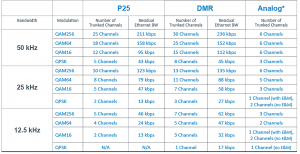Smart Radios Leverage Narrow Slices of Spectrum
A common misconception persists that megahertz bandwidth is needed when linking analogue and digital LMR base station sites. As a result of these misconceptions, narrowband radio may be unjustifiably discounted as a backhaul solution for LMR and other higher bandwidth applications, when in fact it may be an ideal solution.
Here are the reasons why.
The scarcity of spectrum
Firstly, we start with a bit of background about spectrum. The unique propagation properties associated with UHF radio waves make UHF the most sought after and, consequently, crowded band in the usable spectrum. As a result of this demand, the spectrum in these valuable bands has over time been parcelled into smaller slices in order to support the increase in users and to optimize the utility of this rare, finite (and often costly) resource.
Previously, the linking of radio infrastructure had often utilized UHF frequencies due to the advantageous propagation properties and their predictability in relation to latency, jitter and link availability. In recent years, as the world became more data hungry and IP increasingly became the dominant protocol (even for the world of radio), the assumption arose that digital LMR networks would equally require larger bandwidth than could be supported in narrowband channels. And since the slices of available spectrum were getting thinner, clearly narrowband wasn’t going to be up to the challenge.
Working smarter
In actual fact, the requirement for a low-latency, high availability LMR linking solution is less about the “megahertz bandwidths” and is more to do with achieving ultra-spectral efficiency via smart radio design. A narrowband system which has been carefully engineered to meet the exacting Quality of Service (QoS) requirements of critical LMR communications actually has the ability to outperform a system which has been selected solely on the large amounts of available bandwidth. If aspects such as latency, jitter, fade resistance, packet loss and interference mitigation are not attended to, an excess of available bandwidth won’t be enough to ensure the maintenance of critical communications.
The golden solution for LMR linking is therefore not only having enough brawn (data throughput) but also enough brains in terms of both radio and link design to ensure the more nuanced aspects of radio communications are upheld.
Packing in the voice channels
The table below outlines the typical number of voice channels available in 12.5, 25 & 50 kHz channels using Mimomax Tornado radios for linking. (Legacy analogue channels can also be supported using a Four Wire Audio interface.) The residual bandwidth for P25 and DMR in the table is available to be used for LMR link management, to carry additional data traffic between sites or, depending on the ethernet’s non-VoIP data rate requirements, to carry more channels.

As demonstrated above, Mimomax is capable of delivering a significant number of P25 and DMR voice channels – possibly more than the average user would even require – and we make this possible within narrow slices of spectrum.
How is this possible?
Mimomax achieves this result through the use of advanced communication technologies – MIMO (multiple-input, multiple-output), full duplex communications, high orders of modulation and space–time diversity. Along with a data acceleration protocol which assigns priority to critical data packets, this combination enables us to provide very high capacity in narrow bandwidths and to therefore offer the highest spectral efficiency available in narrowband channels.
Incorporating a sophisticated compression algorithm, QoS management and forward-error correction-processing architecture also boost the reliability of the radio’s performance. Furthermore, the Tornado radio uses fast-training algorithms for equalizing in fading channel conditions which increase the availability of the link – central to the requirements of critical communication.
LMR Requirements
So, if big bandwidth alone won’t guarantee you reliability with your LMR backhaul, what should you be looking for?
- Issues such as delay (latency), variation in delay (jitter), packet loss, late packet arrival and availability can become very significant when it comes to mission critical communications. Carefully compare rates for latency, jitter and bit errors between vendors.
- Look for radios which can rapidly re-train in the presence of destructive interference. The result will be higher link availability which is a must for critical communications.
- Optimum linking solutions are those that support comprehensive Forward Error Correction schemes – but not at the cost of excessive latency. Double check this feature with your vendor.
By being aware of these issues and by using a combination of intelligent radio design and smart software features, it’s possible to support a large number of high-availability LMR channels in narrowband without the need for microwave-level bandwidth. A narrowband solution can provide a cost-effective, quick-to-deploy communication system with coverage you can rely on – even in non-line of sight scenarios and across challenging terrain.
*Analog is supported via Mimomax’s Four Wire Audio Interface.
